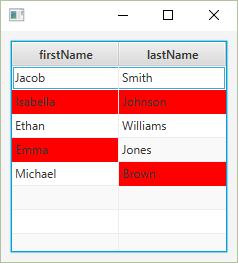JavaFXのTableViewのセルに対してCSSのクラスを追加することはできるのか、ということを調べました。調べた結果、ひとつの方法がわかったのでそれを紹介します。途中は基本的な作りの紹介と説明です。本質的な部分は一番最後に登場します。
使ったCSSと画面
画面は以下です。TableViewは2つの列、firstNameの列、lastNameの列から構成されます。
赤い背景色のセルはCSSのクラスが追加されたセルです。以下のCSSファイルを適用しています。
.tableCellClass {
-fx-background-color: red;
}
tableCellClassというクラスの要素について、背景色を赤くするというCSSです。
画面起動時に以下の動作をして、セルにクラスを追加しています。
- firstNameの列は、内容が「a」で終わる場合、CSSのクラス「tableCellClass」を追加。
- lastNameの列は、内容が「n」で終わる場合、CSSのクラス「tableCellClass」を追加。
TableViewの行に対応するクラス
以下のクラスをTableViewの行に対応させています。
public class Person {
private String firstName;
private String lastName;
public Person(String firstName, String lastName) {
this.firstName = firstName;
this.lastName = lastName;
}
public String getFirstName() {
return firstName;
}
public String getLastName() {
return lastName;
}
public void setFirstName(String firstName) {
this.firstName = firstName;
}
public void setLastName(String lastName) {
this.lastName = lastName;
}
}
app.fxml
画面を構成するfxmlは以下です。stylesheets要素がCSSを指定する箇所です。
<?xml version="1.0" encoding="UTF-8"?>
<?import java.net.URL?>
<?import javafx.scene.control.TableColumn?>
<?import javafx.scene.control.TableView?>
<?import javafx.scene.layout.AnchorPane?>
<?import javafx.scene.layout.BorderPane?>
<BorderPane prefHeight="231.0" prefWidth="236.0"
xmlns="http://javafx.com/javafx/" xmlns:fx="http://javafx.com/fxml/1"
fx:controller="test.AppController">
<stylesheets>
<URL value="@app.css" />
</stylesheets>
<center>
<AnchorPane prefHeight="200.0" prefWidth="200.0"
BorderPane.alignment="CENTER">
<children>
<TableView fx:id="tableView" prefHeight="200.0" prefWidth="200.0"
AnchorPane.bottomAnchor="10.0" AnchorPane.leftAnchor="10.0"
AnchorPane.rightAnchor="10.0" AnchorPane.topAnchor="10.0">
<columns>
<TableColumn fx:id="colFirstName" prefWidth="75.0"
text="firstName" />
<TableColumn fx:id="colLastName" prefWidth="75.0"
text="lastName" />
</columns>
</TableView>
</children>
</AnchorPane>
</center>
</BorderPane>
起動クラス
起動するためのクラスが以下です。
import java.io.IOException;
import javafx.application.Application;
import javafx.fxml.FXMLLoader;
import javafx.scene.Scene;
import javafx.scene.layout.BorderPane;
import javafx.stage.Stage;
public class Main extends Application {
public static void main(String[] args) {
launch(args);
}
@Override
public void start(Stage stage) {
BorderPane root;
try {
root = (BorderPane)FXMLLoader.load(getClass().getResource("app.fxml"));
Scene scene = new Scene(root);
stage.setScene(scene);
stage.show();
} catch (IOException e) {
e.printStackTrace();
}
}
}
セルにCSSのクラスを設定する
以下が画面をコントロールをするクラスです。
import java.net.URL;
import java.util.ResourceBundle;
import javafx.collections.FXCollections;
import javafx.collections.ObservableList;
import javafx.fxml.FXML;
import javafx.fxml.Initializable;
import javafx.scene.control.TableCell;
import javafx.scene.control.TableColumn;
import javafx.scene.control.TableView;
import javafx.scene.control.cell.PropertyValueFactory;
public class AppController implements Initializable {
@FXML TableView<Person> tableView;
@FXML TableColumn<Person, String> colFirstName;
@FXML TableColumn<Person, String> colLastName;
@Override
public void initialize(URL location, ResourceBundle resources) {
// 列の自動調整
tableView.setColumnResizePolicy(TableView.CONSTRAINED_RESIZE_POLICY);
// 列の紐づけ
colFirstName.setCellValueFactory(new PropertyValueFactory<Person, String>("firstName"));
colLastName.setCellValueFactory(new PropertyValueFactory<Person, String>("lastName"));
ObservableList<Person> data =
FXCollections.observableArrayList(
new Person("Jacob", "Smith"),
new Person("Isabella", "Johnson"),
new Person("Ethan", "Williams"),
new Person("Emma", "Jones"),
new Person("Michael", "Brown")
);
tableView.setItems(data);
// セルのコールバックを設定
colFirstName.setCellFactory(tableColumn -> {
return new TableCell<Person, String>() {
@Override protected void updateItem(final String item, final boolean empty) {
super.updateItem(item, empty);
if (empty || item == null) {
setText(null);
setGraphic(null);
} else {
setText(item.toString());
// 対象外にスタイル設定されていた場合、削除する。
getStyleClass().remove("tableCellClass");
// スタイルを設定する。
if (item.endsWith("a")) {
getStyleClass().add("tableCellClass");
}
}
}
};
});
colLastName.setCellFactory(tableColumn -> {
return new TableCell<Person, String>() {
@Override
protected void updateItem(final String item, final boolean empty) {
super.updateItem(item, empty);
if (empty || item == null) {
setText(null);
setGraphic(null);
} else {
setText(item.toString());
// 対象外にスタイル設定されていた場合、削除する。
getStyleClass().remove("tableCellClass");
// スタイルを設定する。
if (item.endsWith("n")) {
getStyleClass().add("tableCellClass");
}
}
}
};
});
}
}
上記のTableColumn#setCellFactory()メソッドを呼び出している部分が、今回のポイントです。セルに変更があった場合、Cell#updateItem()メソッドが呼び出されるようです。それを利用して、クラスの設定を記述しています。「getStyleClass().add("tableCellClass");」の箇所です。
updateItem()メソッドの書き方ですが、API仕様書のCellのページに標準的な実装が記載されてました。以下が標準的のようです。
protected void updateItem(T item, boolean empty) {
super.updateItem(item, empty);
if (empty || item == null) {
setText(null);
setGraphic(null);
} else {
setText(item.toString());
}
}
上記のelseの方にクラスの設定を記述しているのですが、その前に「getStyleClass().remove("tableCellClass");」を記述しています。これはセルにクラスが残ってしまうのを回避するためです。列のヘッダー部分をクリックするとソート処理が行われ、表示順序が変わります。そのときにセルに残ったクラスを削除する処理です。
